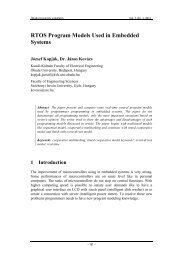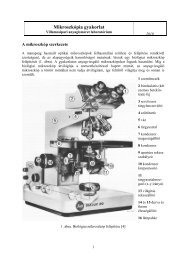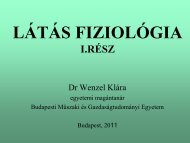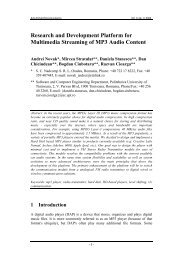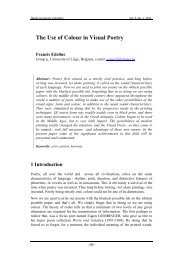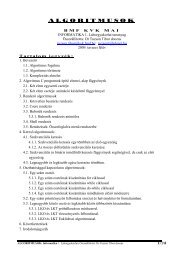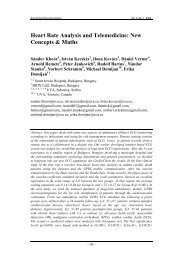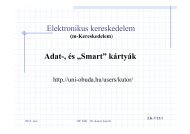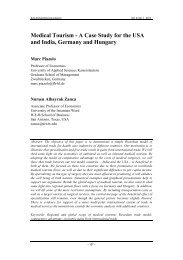Twin Concept of Fine Structure Constant as the 'Self Number ...
Twin Concept of Fine Structure Constant as the 'Self Number ...
Twin Concept of Fine Structure Constant as the 'Self Number ...
You also want an ePaper? Increase the reach of your titles
YUMPU automatically turns print PDFs into web optimized ePapers that Google loves.
P. Várlaki et al. <strong>Twin</strong> <strong>Concept</strong> <strong>of</strong> <strong>Fine</strong> <strong>Structure</strong> <strong>Constant</strong> <strong>as</strong> <strong>the</strong> ‘Self <strong>Number</strong>-Archetype’ Part I: Observation, …<br />
This general formula expresses that <strong>the</strong>re are different courses and rhythms for <strong>the</strong><br />
circulation <strong>of</strong> <strong>the</strong> circle with unit radius. If x is 32, <strong>the</strong> value <strong>of</strong> <strong>the</strong> expression is<br />
136.99…, which means that from a practical point <strong>of</strong> view x = 32 (33) generalizes<br />
<strong>the</strong> number archetype 137. In <strong>the</strong> following parts <strong>of</strong> <strong>the</strong> paper we shall give manifold<br />
interpretations for <strong>the</strong> twin concept <strong>of</strong> FSC and <strong>the</strong> controlling and observing<br />
character <strong>of</strong> this equation.<br />
The selection <strong>of</strong> 360 = 36 × 10 seems to be very natural for us. In Pauli’s dream,<br />
<strong>the</strong> number 32 in <strong>the</strong> given context and <strong>the</strong> “spiritual environment” generates <strong>the</strong><br />
number 360. The 36 is a pair <strong>of</strong> 32 in Pauli’s thinking (see his preoccupation with<br />
32-36 and 137 [43]). The ten (10 = 3 + 7) is a permanent factor in Pauli’s dreams.<br />
The 36 is a strong number archetype in a Jungian sense. It h<strong>as</strong> a mediator role because<br />
it h<strong>as</strong> objective importance <strong>as</strong> <strong>the</strong> first composed natural number (6 2 = 36, 3<br />
× 12 = 36, 4 x 9 = 2 2 x 3 2 = 36). As well, <strong>the</strong> number 36 h<strong>as</strong> some human <strong>as</strong>pects.<br />
Symbolically 1–δ and 1+δ can express an oppositional property for <strong>the</strong> two circulations<br />
using <strong>the</strong> step length <strong>of</strong> <strong>the</strong> rhythm <strong>of</strong> circulation. This oppositional character<br />
<strong>of</strong> delta can be interpreted in symbolic ma<strong>the</strong>matics <strong>as</strong> an “orthogonal, perpendicular”<br />
relationship. 5<br />
3 The Dream <strong>of</strong> <strong>the</strong> World Clock <strong>as</strong> a “Geometric-<br />
Algebraic” Archetype <strong>of</strong> Control Systems and <strong>the</strong><br />
Self<br />
Jung quite frequently speaks <strong>of</strong> his patients’ dreams containing symmetry structures<br />
which are very similar to <strong>the</strong> “Ezekiel pattern”, without any knowledge <strong>of</strong><br />
<strong>the</strong> vision <strong>of</strong> Ezekiel. He remarks that, despite its significance in <strong>the</strong> spiritual history<br />
<strong>of</strong> <strong>the</strong> Christian-Jewish world, even among highly educated people, <strong>the</strong>re is<br />
an almost complete ignorance “<strong>of</strong> this field”. Jung cl<strong>as</strong>sified <strong>the</strong>se kinds <strong>of</strong> dreams<br />
<strong>as</strong> Mandala dreams, which can be experienced <strong>as</strong> a kind <strong>of</strong> psychic syn<strong>the</strong>sis <strong>of</strong> a<br />
psychoid transcendental background and real psychic “foreground”. Fur<strong>the</strong>rmore,<br />
he interpreted <strong>the</strong> appearance <strong>of</strong> <strong>the</strong> possible synchronistic phenomena <strong>as</strong> <strong>the</strong><br />
parapsychological equivalent <strong>of</strong> this transgressive totality (completeness) experience<br />
[21].<br />
“I have always been particularly interested to see how people, if left to <strong>the</strong>ir own<br />
devices and not informed about <strong>the</strong> history <strong>of</strong> <strong>the</strong> symbol, would interpret it to<br />
<strong>the</strong>mselves. I w<strong>as</strong> careful, <strong>the</strong>refore, not to disturb <strong>the</strong>m with my own opinions and<br />
5<br />
It is interesting to note, concerning this dream, Pauli’s crucial remark from one <strong>of</strong> his<br />
letters (to Heisenberg!) on <strong>the</strong> uncertainty principle (1927): “One can look at <strong>the</strong><br />
world ei<strong>the</strong>r with <strong>the</strong> p-eye or one can look at it with <strong>the</strong> q-eye, but if you will simultaneously<br />
open both eyes, you get lost.” [58] (See footnote 7 in Part II!)<br />
– 86 –



